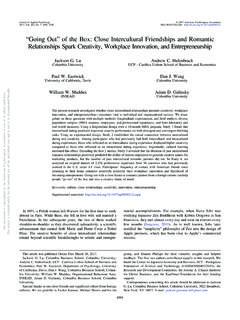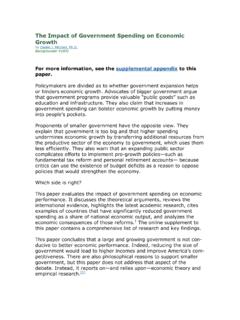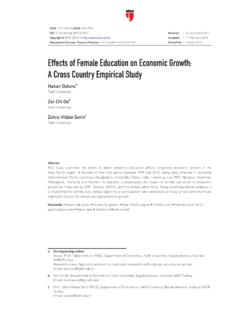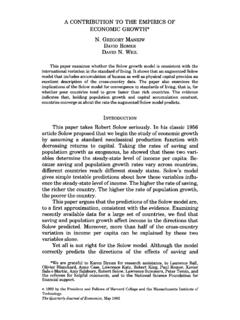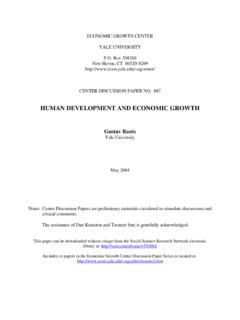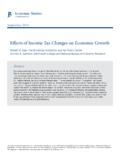Transcription of INEQUALITY AND ECONOMIC GROWTH - Columbia Business …
1 1 INEQUALITY AND ECONOMIC GROWTH Joseph Stiglitz Introduction In the middle of the twentieth century, it came to be believed that a rising tide lifts all boats : ECONOMIC GROWTH would bring increasing wealth and higher living standards to all sections of society. At the time, there was some evidence behind that claim. In industrialized countries in the 1950s and 60s every group was advancing, and those with lower incomes were rising most rapidly. In the ensuing ECONOMIC and political debate, this rising tide hypothesis evolved into a much more specific idea, according to which regressive ECONOMIC policies policies that favour the richer classes would end up benefiting everyone. Resources given to the rich would inevitably trickle down to the rest. It is important to clarify that this version of old-fashioned trickle-down economics did not follow from the post-war evidence.
2 The rising-tide hypothesis was equally consistent with a trickle-up theory give more money to those at the bottom and everyone will benefit; or with a build-out from the middle theory help those at the centre, and both those above and below will benefit. Today the trend to greater equality of incomes, which characterised the post-war period, has been reversed. INEQUALITY is now rising rapidly. Contrary to the rising-tide hypothesis, the rising tide has only lifted the large yachts, and many of the smaller boats have been left dashed on the rocks. This is partly because the extraordinary GROWTH in top incomes has been going along with an ECONOMIC slowdown. The trickle-down notion along with its theoretical justification, marginal productivity theory needs urgent rethinking. That theory attempts both to explain INEQUALITY why it occurs and to justify it why it would be beneficial for the economy as a whole.
3 This chapter looks critically at both claims. It argues in favor of alternative explanations of INEQUALITY , with particular reference to the theory of rent-seeking and to the influence of institutional and political factors, which have shaped labour markets and patterns of remuneration. And it shows that, far from being either necessary or good for ECONOMIC GROWTH , excessive INEQUALITY tends to lead to weaker ECONOMIC performance. In light of this, it argues for a range of policies that would increase both equity and ECONOMIC wellbeing. The great rise of INEQUALITY Let us start by examining the ongoing trends in income and wealth. In the last three decades, those at the top have done very well, especially in the US. Between 1980 and 2013, the richest 1% have seen their average real income increase by 142% (from $461,910, adjusted for inflation, 2 to $1,119,315) and their share of national income double, from 10% to 20%.
4 The top have fared even better. Over the same period, their average real income increased by 236% (from $1,571,590, adjusted for inflation, to $5,279,695) and their share of national income almost tripled, from to Over the same 33 years, median household income grew by only 9%. And this GROWTH actually occurred only in the very first years of the period: between 1989 and 2013 it shrank by But even this underestimates the extent to which those at the bottom have suffered their incomes have only done as well as they have because hours worked have increased. Between 1979 and 2007, workers in the bottom fifth of the wage distribution increased their average annual work hours by 22 percent a greater increase than for any other Median wages (adjusted for inflation) increased by only 5 percent from 1979 to 2012, even though at the same time productivity grew by percent (Figure 1).
5 4 And these statistics underestimate the true deterioration in workers wages, for education levels have increased (the percentage of Americans who are college graduates has nearly doubled since 1980, to 30 percent),5 so that one should have expected a significant increase in wage rates. In fact, average real hourly wages for all Americans with only a high school diploma or a bachelor s degree have decreased in the last three decades. 6 7 In the first three years of the so-called recovery from the Great Recession of 2008-2009 in other words, since the economy returned to GROWTH fully 91% of the gains in income went gone to the top 1%.8 Presidents Bush and Obama both tried a trickle-down strategy giving large amounts of money to the banks and the bankers. The idea was simple: by saving the banks and bankers, all would benefit.
6 The banks would restart lending. The wealthy would create more jobs. This strategy, it was argued, would be far more efficacious than helping homeowners, businesses, or workers directly. The US Treasury typically demands that when money is given to developing countries, conditions be imposed on them, to ensure not only that the money is used well, but that the country adopts ECONOMIC policies that (according to Treasury s ECONOMIC theories) will lead to GROWTH . But no conditions were imposed on the banks not even, for example, requirements that they lend more or stop abusive practices. The rescue worked in enriching those at the top; but the benefits did not trickle down to the rest of the economy. The Federal Reserve, too, tried trickle-down economics. One of the main channels by which quantitative easing was supposed to rekindle GROWTH was by leading to higher stock market prices, which would generate higher wealth for the very rich, who would then spend some of that, which in turn would benefit the rest.
7 As Yeva Nersisyan and Randall Wray argue in their chapter in this volume, both the Fed and the Administration could have tried policies that more directly benefited the rest of the economy: helping homeowners, lending to small and medium-sized enterprises, and fixing the broken credit channel. These trickle-down policies were relatively ineffective one reason that seven years after the US slipped into recession, the economy was still not back to health. 3 Figure 1 Wages, productivity and average incomes in the US (1975 2013) Sources: The State of Working America, 12th ed. by the ECONOMIC Policy Institute (left panel); and (right panel) Wealth is even more concentrated than income . The wealthiest 1% of Americans hold 35% of the country s wealth, and even more when housing wealth is not counted.
8 Just one example of the extremes of wealth in America is the Walton family: the six heirs to the Walmart empire command a wealth of $145 billion, which is equivalent to the net worth of 1,782,020 average American Wealth INEQUALITY too is on the upswing. For the quarter of a century before the Great Recession, the rich were getting wealthier at a more rapid pace than everyone else. When the crisis hit, it depleted some of the richest Americans wealth because stock prices declined, but many Americans also had their wealth almost entirely wiped out as their homes lost value. After the crisis, the wealthiest 1 percent of households had 225 times the wealth of the typical American, almost double the ratio 30 or 50 years ago. In the years of recovery , as stock market values rebounded (in part as a result of the Fed s lopsided efforts to resuscitate the economy through increasing the balance sheet of the rich), the rich have regained much of the wealth that they had lost; the same did not happen to the rest of the INEQUALITY plays out along ethnic lines in ways that should be disturbing for a country that had begun to see itself as having won out against racism.
9 Between 2005 and 2009, a huge number of Americans saw their wealth drastically decrease. The net worth of the typical white American household was down substantially, to $113,149 in 2009, a 16 percent loss of wealth from 2005. But the situation is much worse for other groups. The typical African American household lost 53 percent of its wealth putting its assets at a mere 5 percent of the median white American s. The typical Hispanic household lost 66 percent of its Probably the most invidious aspect of America s INEQUALITY is that of opportunities: in the US a young person s life prospects depend heavily on the income and education of his parents, even more than in other advanced countries12. The American dream is largely a myth. 80901001101201301401501601701801975 1980 1985 1990 1995 2000 2005 2010 ProductivityMedian hourlywage801301802302803303804301975 1980 1985 1990 1995 2000 2005 2010 Bottom 99% average incomeTop 1% average income4 A number of studies have noted the link between INEQUALITY of outcomes and INEQUALITY of When there are large inequalities of income , those at the top can buy for their offspring privileges not available to others, and they often come to believe that it is their right and obligation to do so.
10 And, of course, without equality of opportunity those born in the bottom of the distribution are likely to end up there: inequalities of outcomes perpetuate themselves. This is deeply troubling: given our low level of equality of opportunity and our high level of INEQUALITY of income and wealth, it is possible that the future will be even worse, with still further increases in INEQUALITY of outcome and still further decreases in equality of opportunity. A generalized international trend While America has been winning the race to be the most unequal country (at least within developed economies), much of what has just been described for America has also been going on elsewhere. In the last 25 years the Gini index the widely used measure of income INEQUALITY has increased by roughly 22% in Germany, 13% in Canada, 13% in UK, 8% in Italy and in Japan (Fig.)



